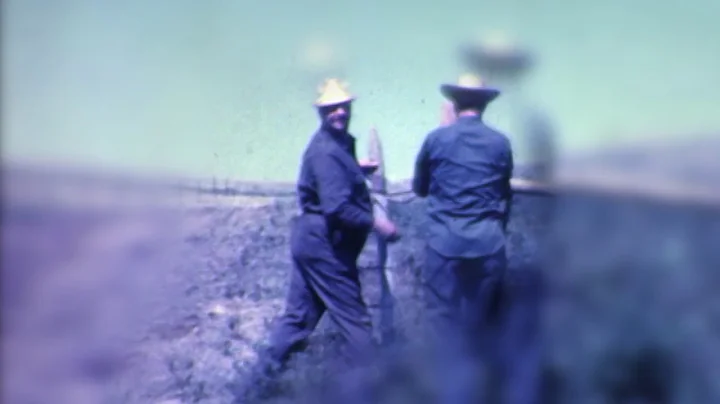A bridge was built over a natural chasm and turned into a thoroughfare.
- A record of the construction of Pingyin Yellow River Bridge
Li Qingyu
In December 1970, a major transportation hub project in the lower reaches of Yellow River was completed, and the Pingyin Yellow River Bridge was born. Just like a rainbow lying on the waves, it is majestic and magnificent. Standing at the head of the bridge and looking westward, the surging river has no end in sight. It reminds people of Li Bai 's poem: "If you don't see it, the water of the Yellow River is coming up from the sky." Then I turned around and looked down, the waves were rolling, pouring thousands of miles, boundless, and I remembered another poem by Li Bai: "When the Yellow River falls, it goes to the East China Sea.
calls out to
In 1855, the Yellow River burst in Henan, seizing the Daqing River all the way north, flowing through After Pingyin County, it immediately brought suffering to the people on both sides of the river. Floods occurred all year round, villages were flooded, traffic was blocked, and logistics was blocked. In order to prevent Beijing and Tianjin from being flooded, high dams were built on the north bank to ensure safety. We can build small embankments and small dams to protect production from small floods and disasters. Once floods come, we can release water from the breaches and floodplains to detain floods, so that the water in the eighteen bays along the river can be driven away by the waves. It is watery in summer, white in winter, and a toad swamp. In the reed swamps, the people had no food to eat, no clothes to cover their bodies, and they were homeless. They fled to beg for food. Countless people drowned, starved to death, and froze to death. "The water of the Yellow River is white and the clouds are yellow, and the people walking by the river are relatively miserable." A true portrayal of the difficult life. According to Pingyin's " County Chronicles ", the Yellow River Gorge also caused tragedies during the Revolutionary War. On April 24, 1947, the Pingyin County Party Committee decided that all cadres and militiamen in the north of the Yellow River should be mobilized. Shan, Wangkou Mountain, and Zishun are the ferry crossings. There are three routes back to the south of the Yellow River. Routes 1 and 2 both landed safely and sneaked into the enemy's rear. The third route, which can be boarded, went to the center of the river. The pole was broken and the boat capsized. 32 All cadres and soldiers fell into the water. This shipwreck brought irreparable losses to the revolutionary cause of Pingyin County. Faced with the pain of being separated by rivers, the common people issued a common cry from the bottom of their hearts, "The Yellow River has been used as cultivated land in ancient times. "All roads are connected to Tianjin, and the sea turns into dust." At the same time, during 1969, the Zhenbao Island incident occurred on the border of our country, and the international situation became tense. In order to strengthen combat readiness, defend against foreign aggression, and safeguard national security, modern military facilities were established , To improve the military's combat capabilities, there is also an urgent need to build a Yellow River Bridge . According to surveys, the Pingyin Yellow River section is far away from the city, the terrain is hidden, and it is easy to defend and difficult to attack. It is a rare military strategic location and has unique advantages in building a bridge. For the above, it can either improve people's livelihood or strengthen war preparedness; it can be used locally or used by the military. The construction of the Yellow River Bridge is of contemporary benefit and will benefit the future. It is urgent and of great significance.
Planning
With the development of the national economy and the growth of national power, the people's The wish to build a bridge over the Yellow River came true. At the end of 1968, the Party Central Committee and the State Council approved the plan report of the Shandong Provincial Revolutionary Committee and the Jinan Military Region on the construction of a highway bridge on the Yellow River section of Pingyin County, and required Shandong Province to strengthen leadership and organize carefully. Plan scientifically and implement it promptly to complete this project that benefits mankind.
In compliance with the instructions of the Party Central Committee and the State Council, the Shandong Provincial Revolutionary Committee and the Jinan Military Region immediately instructed the Design Institute of the Provincial Department of Communications to establish a planning and design team. In January, More than 10 designers were dispatched to the Yellow River section in Pingyin County to select the site. By looking at the terrain, measuring the river bed, measuring the water level, exploring the river bottom, and evaluating the construction conditions and connecting routes, two plans were drawn up. One was to build the bridge outside the mountain. The plan and site selection include Waishan on the right bank and Aishan on the left bank. This plan looks at the favorable conditions: “The two mountains face each other, the river channel is stable, the distance is short, and the investment is small. "From the perspective of unfavorable conditions: "There are mountains on both sides, making it difficult to connect; the river is narrow, the water flow is fast, and the erosion force on the bridge is strong, especially during the freezing and flood periods, it is expected that the probability of icebergs blocking the bridge holes is high. "The second is the Longqiao bridge construction plan. The site selection site is Longqiao Village on the right bank and Yuwo Village on the left bank. This plan looks at the favorable conditions: "The river channel is wide, the flow speed is slow, the water surface is stable, and the scouring force on the bridge is small. ; The right bank is a mountain and the left bank is a beach, making construction and wiring convenient. "From the perspective of unfavorable conditions: "The river channel is wide, the approach bridge is long, and the investment is large."
From February 19 to 21, 1969, the Provincial Revolutionary Committee and the leaders of the Jinan Military Region convened responsible comrades from 24 relevant units including the Provincial Yellow River Affairs Bureau, Tai'an , Liaocheng , Pingyin, Dong'a and so on. Some local people's representatives visited the two bridge construction sites and listened to the comprehensive survey report of the technical personnel. Everyone agreed that although the Waishan bridge construction plan has low investment and low cost, it has high risks and many hidden dangers, and it is not a foolproof strategy. Although the investment and cost of the plan are high, it is easy to construct, has low risks, has few hidden dangers, takes up time and space, and has practical value. After analysis and comparison, the Long Bridge construction plan was finally approved and planned in detail. The bridge has a total length of 963.5 meters, a width of 10 meters, and a height of 14.8 meters. It is composed of a main bridge and an approach bridge. The main bridge has 6 holes and is 611 meters long. The approach bridge has 10 holes and is 352.5 meters long. It is prefabricated. It is a stress-reinforced concrete structure with a maximum load-bearing capacity of 60 tons. There are two bridgeheads at each end of the bridge, which is connected to the "105" National Highway.
Regarding the naming of the bridge, many opinions and suggestions were solicited. Everyone has different opinions and wisdom. . The "Luxi Yellow River Bridge", "Tailiao Yellow River Bridge", "Ping'a Yellow River Bridge", "Longyu Yellow River Bridge", "Pingyin Yellow River Bridge", "Dong'a Yellow River Bridge", etc. were proposed as references. Commander Yang Dezhi of the Jinan Military Region believed that two-thirds of the bridge belonged to Pingyin County and it was natural to highlight the word "Pingyin". Later, Commander Yang reported to Premier Zhou Enlai of the State Council and decided to name the bridge "Pingyin". "Yellow River Bridge".
organized
to build the Yellow River Bridge. Overall arrangement and careful organization were the prerequisites. In view of the fact that it was in the special period of the Cultural Revolution, the state characterized the construction of the bridge as a military project and made it clear that the Jinan Military Region was fully responsible. The Jinan Military Region actively responded to the superiors' orders According to the call, nearly a hundred commanders and fighters were transferred to establish the Pingyin Yellow River Bridge Construction General Headquarters. Ma Lianhui, the commander of a certain military pontoon bridge unit, was appointed as the general commander, and Li Ruiyun, the political commissar of the 200th Division of a certain unit, was appointed as the deputy commander-in-chief. The Tai'an and Liaocheng military divisions were established. The Tai'an branch organized the Pingyin County migrant workers' corps, and the Liaocheng branch organized the Dong'a County migrant workers' corps. The general headquarters coordinated the bridge construction tasks, clearly divided the work, and assigned responsibilities to the people in Shandong Province. The Design Institute of the Department of Transportation is responsible for the design; the Engineering Brigade of the Provincial Department of Transportation organizes the construction; the Tai'an branch headquarters organizes the Pingyin migrant workers' group and the Liaocheng branch headquarters organizes the Dong'a migrant workers' group to cooperate with the construction.
In late April of that year, Commander Ma Lianhui led the provincial command. The whole team came to Longqiao Village, Pingyin County to set up camp and put up a sign saying "Pingyin Yellow River Bridge Construction Headquarters". The Tai'an branch headquarters was also located in Longqiao Village, and the Liaocheng branch headquarters was located in Longqiao Village. Yuwo Village in Hebei Province is organized according to the militia system. The Pingyin County Workers' Group has 1,200 people and is organized into 3 battalions, 12 companies and 48 platoons; the Dong'a Workers' Group has 1,200 people and is also organized into 3 battalions and 12 platoons. Company 48 platoon. Teams at all levels are led by the main leaders of regional military divisions, county armed departments, commune armed departments, and villager companies. After the notice to start construction was officially issued, 50 engineering and technical personnel from the Engineering Brigade of the Department of Transportation came to the construction site carrying piling boats, transport ships, rubber boats, cranes, mixers, etc. More than 2,000 migrant workers flocked to the construction site from all directions. The village where the construction site was located vacated houses for migrant workers to live in, and vacated cooking stoves for migrant workers to use as they did before the construction. Although the masses were enthusiastic, the team was huge and there were many people. , the existing houses still cannot meet the needs. Reluctantly, many militia companies took matters into their own hands and built simple work sheds using tarpaulins and reed mats for temporary housing of migrant workers. There was no ready-made pot or stove, so they used stones to prop up iron pots and boiled water for cooking. Although the conditions were difficult at that time, everyone believed that building the Yellow River Bridge would be a contribution to the present and benefit to the future, and it was worth the hardship and suffering!
Construction
On May 1, 1969, the battle to build the Yellow River Bridge began. Building bridge piers requires blocking the flow of water, exposing the river bottom, clearing the foundation and driving piles. However, the Yellow River is still at a high water level, large flow, and rapid speed. Construction under such circumstances is difficult, difficult, very difficult! At this time, engineering and technical personnel drew up three plans. One is to temporarily change the course of the Yellow River and expose the bottom of the river for construction.The second is to wait until there is a severe drought and the Yellow River dries up before starting construction; the third is to overcome difficulties, create conditions and start construction immediately. After analysis and decision-making by the general headquarters, the first option was affected by the geographical environment and there was no condition to divert the Yellow River to ; the second option would delay the construction period until the Yellow River dried up; only the third option was feasible. Under the strong mobilization of the general headquarters, everyone strengthened their determination and confidence to overcome the difficulties, and unanimously stated that the bridge should be built if conditions exist. If conditions do not exist, the bridge should be built if conditions are created. The engineering and technical personnel reviewed the information and learned from experience, and established the implementation plan of "building embankments, cofferdams, pumping water and digging wells". That is, at the position of the bridge pier, steel plates are driven into the river bottom to make a circular cofferdam with a diameter of 25 meters. The water flow is first blocked, and then the water in the weir is pumped out. When the water is drained, the river bottom is exposed. . Because the Yellow River has a large amount of sediment, a high river bed, and thick silt, the river bottom is still ten or even dozens of meters away from the rocks. Manual dredging is required, which is labor-intensive, time-consuming, and inefficient. In order to speed up the progress, technicians used high-pressure water guns to wash away the sediment, and then used a water pump to pump out the water with sediment. The implementation of this method was fast and efficient, and the rocks on the river bottom were quickly washed out. After the rock was exposed, the geological drilling team immediately erected a tall derrick and started drilling central holes. The diameter of the central holes was 1.5 meters and the depth was about 20 meters. Four holes were drilled for each bridge pier. According to this plan, the construction team built 16 cofferdams and drilled 84 central holes in half a year, laying the foundation for the bridge construction.
After the foundation clearing is completed, the construction enters the most critical link - pouring the bridge piers with concrete. Pouring the bridge piers requires strict operating procedures. In addition to the cement, steel bars, sand and gravel and other materials meeting the standards, the entire pouring process needs to be completed in one go. If there is a pause or intermittent in the middle, Gaps or defects will appear in the concrete, affecting the quality of the bridge. According to this demand, whenever a bridge pier is cast, the general headquarters holds a swearing-in meeting and organizes all officers and soldiers, all technical personnel, and all migrant workers to carry out a general battle. The entire battle scene was full of excitement and excitement. In the lumber yard, electric saws rustled, adzes and axes cracked, and the masters worked hard to make molds. The masters of the steel construction team cut steel and iron, tied knots, flashed their welding guns, and quickly tied up the steel cages. In the pouring construction team, more than 2,000 migrant workers lifted up the beams. They were busy loading and unloading trucks while wielding shovels and pickaxes; vehicles transporting materials on both sides of the Yellow River and ships transporting materials in the river came and went in an endless stream; The mixers, cranes, and vibrators at the pouring site were rumbling, working overtime, day and night. Climbing ladders and carrying cement during construction is the most difficult, tiring and dangerous task. Iron clouds stand straight up and down on the boat, as high as a 6-story building. Below is the roaring Yellow River. People carry 100 tons of cement on their bodies to climb up. The degree of danger can be imagined. To this end, the headquarters selected Communist Party members and strong young people to form a commando team of more than 200 people. They were not afraid of difficulties and dangers, charged into the battle, and fought hard. Chen Zhenting, a key militiaman of the Pingyin County Migrant Workers' Corps, is strong and powerful. He was originally a carpenter and his work was relatively light. When he heard that a commando team was to be set up for the pouring construction, he immediately signed up and joined the team. During the work, others were carrying a bag of cement. , he carried two bags at a time and worked for three days and three nights. Comrade Ma Lian Guanghui, the commander-in-chief of the provincial headquarters, is both a commander and a combatant. Regardless of his age of 60 years, he takes the lead in climbing high ladders and carrying cement, which is deeply respected by the majority of migrant workers. Comrade Sun Hongye, political commissar of the Pingyin County Labor Corps, suffered from a fear of heights and would feel dizzy when climbing a ladder. However, he put his life at risk for the cause of building a bridge and did not get off the line of fire for three consecutive days. Afterwards, he fell down. Hypertension ,heart disease. At the same time, the construction of the bridge has also affected the hearts of the people in Tai'an and Liaocheng. Government officials and students from universities and technical secondary schools in the two regions have used Sundays and holidays to participate in voluntary labor to support the construction of the bridge.
During the construction of the bridge, engineering and technical personnel not only focused on reality, but also faced the future and boldly carried out technological innovation. In the past, welding technology was mostly used when erecting steel beams. Once the bridge was destroyed and could not be dismantled or cut, it would be scrapped as a whole.In this work of connecting steel beams, technicians summed up past lessons and adopted rivet connection technology. This technology is suitable for combat readiness. If the bridge is partially destroyed, the scrap parts can be immediately disassembled and new parts reinstalled to quickly restore the bridge to traffic. . In addition, lumpy stones are used to build the bridge pier retaining walls, which effectively reduces the scouring force of floods on the bridge piers.
Construction of the bridge adheres to the principle of "a century-old plan and quality first". The headquarters has set up a quality supervision team to strictly control the materials, so that unqualified materials are not allowed to enter; to strictly control the construction, if unqualified projects are found, they will tear them down and start over, and resolutely rework them; to strictly control the acceptance, whoever checks and accepts will sign. , who bears the legal responsibility; strictly control economy, practice economy, oppose waste, and create a new record of saving 600 million yuan in bridge construction.
Opening to traffic
On December 1, 1970, the Pingyin Yellow River Bridge held a ribbon-cutting ceremony for its opening to traffic. More than 10,000 people in total attended the conference, including leaders of relevant central ministries and commissions, relevant leaders of provincial government agencies, relevant leaders of Tai'an District and Liaocheng areas, and cadres and masses from Pingyin County and Dong'e County. Yang Dezhi, commander of the Jinan Military Region and director of the Provincial Revolutionary Committee, and Yuan Shengping, political commissar of the Jinan Military Region, attended the meeting and cut the ribbon for the opening of the bridge to traffic. The main venue is located on the south side under the bridge. A huge logo is hung in the center of the venue. Colorful flags are placed on both sides of the bridge. Firecrackers are blasting and gongs and drums are loud in the venue. Commander Yang Dezhi and Commander-in-Chief Ma Lianhui deliver enthusiastic speeches respectively. In his speech, he commended a large number of heroes who built the bridge. At 10 o'clock in the morning, as Commander-in-Chief Ma Lianhui said: "The ribbon is cut for the opening to traffic!" rows of jeeps and Jiefang Automobiles drove past rapidly from south to north. Thick crowds of people crowded along both sides of the Yellow River. Wherever the car went, there were cheers, gongs, drums, and firecrackers. Uncle Chen, who is over 70 years old in Longqiao Village, Pingyin County, said with tears in his eyes: "In the past, my son drowned due to a shipwreck in the Yellow River. I suffered for most of my life. Now I am better. The Communist Party and Chairman Mao have given me great help." We built the Xingfu Bridge. "
After the Pingyin Yellow River Bridge was completed, it connected National Highway 105, which became an important channel connecting the provincial capital Jinan to western Shandong and southwestern Shandong. According to statistics, the daily traffic volume exceeds 10,000 vehicles, which plays an important role in promoting the prosperity of the economy on both sides of the Yellow River.
Yidian account Li Qingyu
is looking for reporters, reports and help. Download the "Qilu Yidian" APP from major application markets or search the WeChat applet "Yidian Information Station". More than 600 mainstream media reporters across the province are waiting for you online. Report!




![At the end of a rainbow - Earl Grant HD] - DayDayNews](https://i.ytimg.com/vi/BCe0Y17qv5o/hqdefault.jpg?sqp=-oaymwE2COADEI4CSFXyq4qpAygIARUAAIhCGAFwAcABBvABAfgBjgOAAuIBigIMCAAQARgXIEYofzAP&rs=AOn4CLDy_ggjXqa-o81RbMJ2V9bgc5SX0A)

















